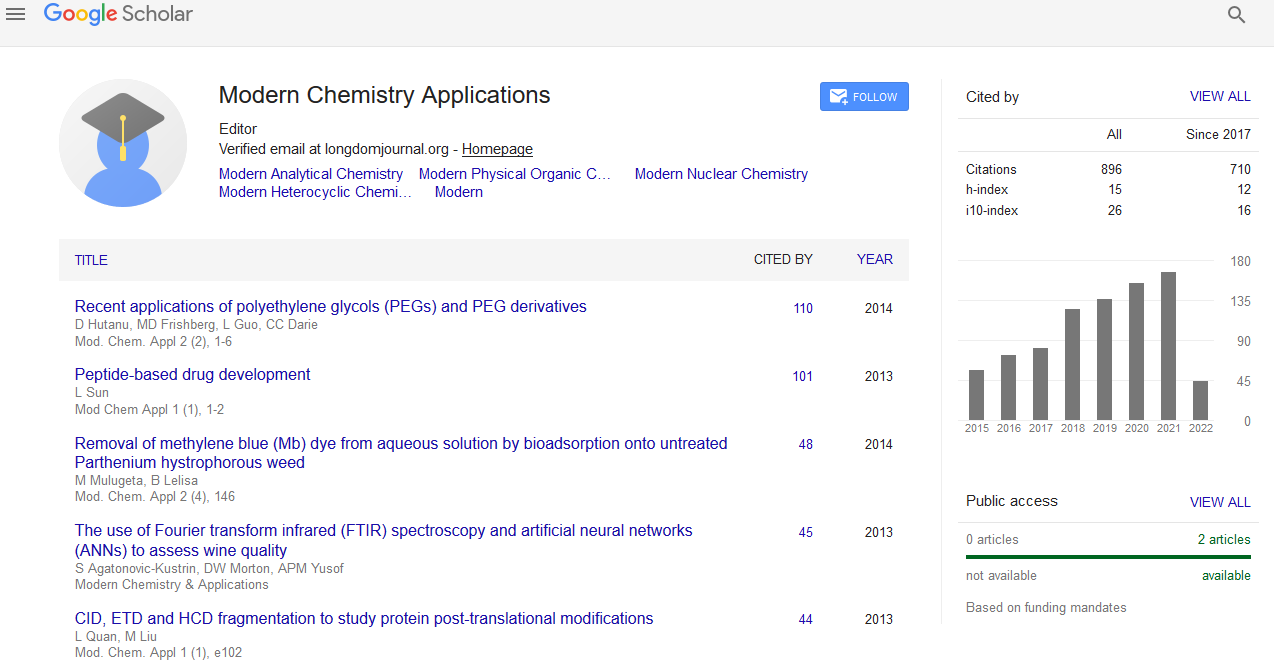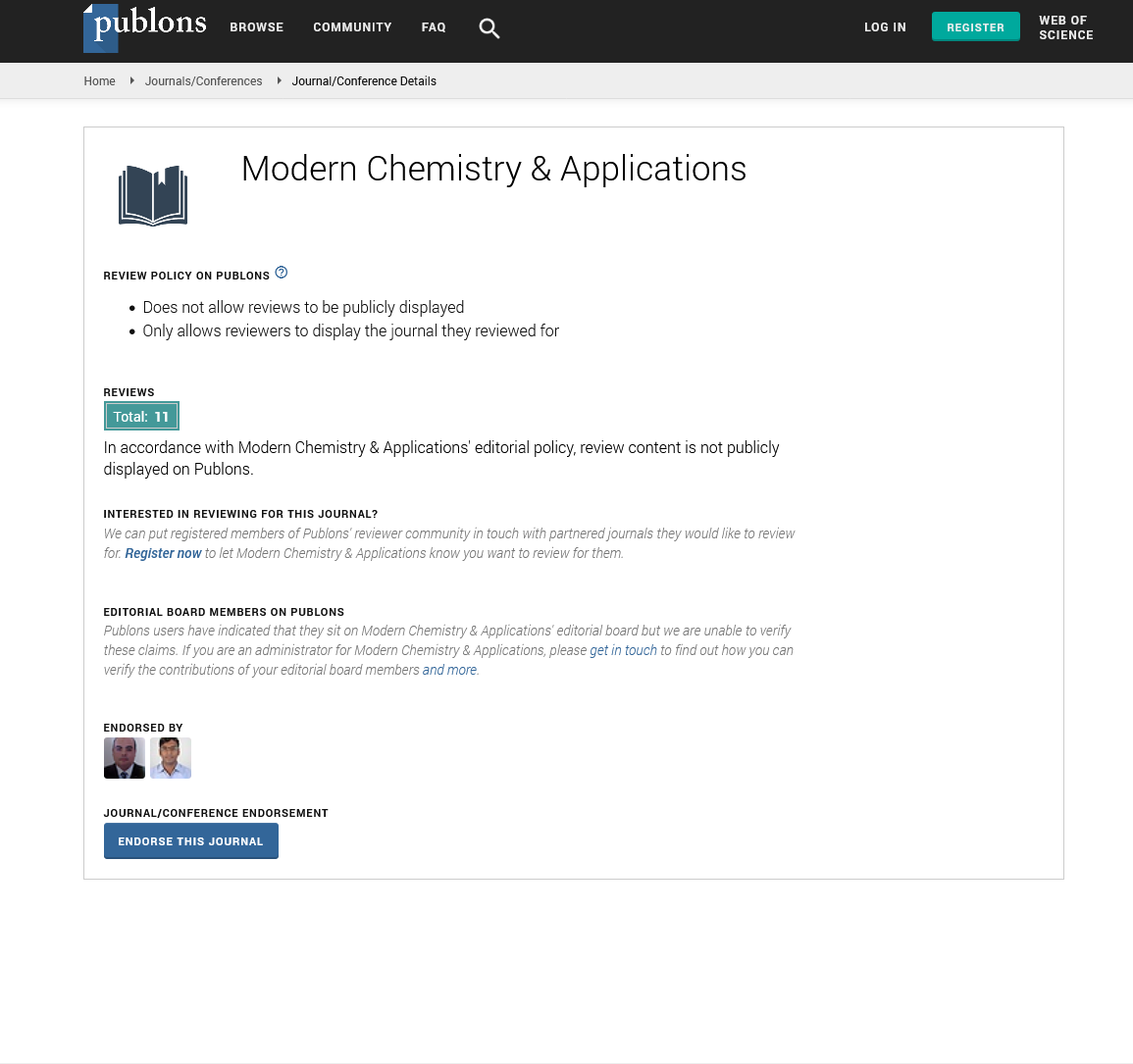Indexed In
- Open J Gate
- JournalTOCs
- RefSeek
- Hamdard University
- EBSCO A-Z
- OCLC- WorldCat
- Scholarsteer
- Publons
- Geneva Foundation for Medical Education and Research
- Google Scholar
Useful Links
Share This Page
Journal Flyer

Open Access Journals
- Agri and Aquaculture
- Biochemistry
- Bioinformatics & Systems Biology
- Business & Management
- Chemistry
- Clinical Sciences
- Engineering
- Food & Nutrition
- General Science
- Genetics & Molecular Biology
- Immunology & Microbiology
- Medical Sciences
- Neuroscience & Psychology
- Nursing & Health Care
- Pharmaceutical Sciences
Opinion Article - (2024) Volume 12, Issue 4
Quantum Chemistry Approaches to Understanding Chemical Reactions at the Atomic Scale
Klaus Müller*Received: 28-Nov-2024, Manuscript No. MCA-24-28408; Editor assigned: 02-Dec-2024, Pre QC No. MCA-24-28408 (PQ); Reviewed: 16-Dec-2024, QC No. MCA-24-28408; Revised: 23-Dec-2024, Manuscript No. MCA-24-28408 (R); Published: 30-Dec-2024, DOI: 10.35248/2157-7560.24.12.482
Description
Quantum chemistry is a branch of science that uses the principles of quantum mechanics to explain chemical reactions and processes at the atomic and molecular levels. Unlike classical chemistry, which often relies on macroscopic observations, quantum chemistry provides a microscopic view of how atoms and molecules interact, bond and change during chemical reactions. This approach enables scientists to explore chemical phenomena that are otherwise difficult to observe directly, offering deep insights into the nature of chemical reactions. At its core, quantum chemistry involves solving the Schrödinger equation, which describes the behavior of particles at the quantum level. This equation is fundamental to understanding how atoms and molecules behave in different chemical environments. However, the complexity of the equation often requires approximations and computational methods to obtain practical solutions. Quantum chemistry allows researchers to calculate molecular properties such as bond energies, molecular structures and reaction mechanisms, all of which are critical for designing new materials, catalysts and reactions. In many cases, chemical reactions can involve several steps or intermediates, which are difficult to detect experimentally.
Quantum chemistry can help identify and characterize these intermediates by calculating Potential Energy Surfaces (PES). The PES provides a map of how the energy of a system changes as the positions of atoms change. By analyzing these surfaces, scientists can predict reaction pathways, identify transition states and determine the most favorable reaction mechanisms. This allows for a deeper understanding of how reactions proceed, what factors influence their efficiency and what conditions might be required to optimize them. Computational methods in quantum chemistry are also important when exploring the reactivity of different molecules. For example, when investigating the catalytic activity of a metal or enzyme, quantum chemical calculations can reveal the nature of the interactions between the catalyst and reactants.
This helps chemists design more efficient catalysts by providing insight into how different metal centers or functional groups affect reaction rates. By predicting how specific molecules will behave under certain conditions, quantum chemistry can play a vital role in developing sustainable processes, such as the conversion of CO2 into useful chemicals. In addition to traditional quantum chemical approaches, advancements in computational power have enabled the use of more advanced methods, such as Density Functional Theory (DFT) and coupledcluster theory. DFT, in particular, has become one of the most widely used methods for simulating chemical reactions due to its balance between accuracy and computational efficiency.
It allows researchers to study systems with a large number of atoms, making it applicable to complex reactions involving organic molecules, biomolecules, or even materials science. While DFT does not provide an exact solution to the Schrödinger equation, it offers a good approximation that can be applied to systems where exact solutions are not feasible. Quantum chemistry also plays an essential role in the design of new materials and drugs. By understanding the electronic and structural properties of molecules, researchers can predict how new compounds will behave in chemical reactions. This is particularly important in drug design, where the ability to model molecular interactions at the atomic level can lead to the development of more effective therapies. Similarly, in materials science, quantum chemistry can help identify new materials with desirable properties, such as high conductivity, strength, or catalytic activity.
In conclusion, quantum chemistry offers an invaluable approach to understanding chemical reactions by examining atomic interactions and electron distributions in a way that traditional methods cannot. Its ability to provide insights into reaction mechanisms predict product outcomes and design new materials makes it a powerful tool for both fundamental research and industrial applications.
Citation: Müller K (2024). Quantum Chemistry Approaches to Understanding Chemical Reactions at the Atomic Scale. Modern Chem Appl. 12:482.
Copyright: © 2024 Müller K. This is an open access article distributed under the terms of the Creative Commons Attribution License, which permits unrestricted use, distribution, and reproduction in any medium, provided the original author and source are credited.


